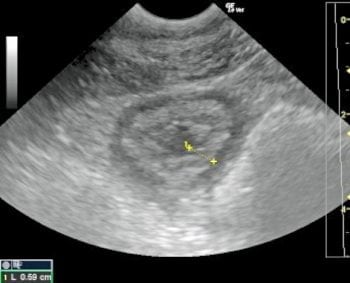17 Sept 2018
Hattie Sparks reports on a case involving a six-month-old recently weaned Thoroughbred colt in the latest Case Notes.

Figure 1. Filling under the jaw and muzzle of the weanling.
On physical examination, the foal is quiet and has a body condition score of three out of nine, with a dull, staring coat. No diarrhoea is reported and no signs of colic are evident. Ventral oedema is noted under the jaw, belly and sheath of the foal.
Clinical examination reveals a heart rate of 68bpm; respiratory rate of 20 breaths per minute; pale, tacky mucous membranes; and a temperature of 39.6°C.
The ventral oedema suggests a protein-losing complication and, given the age of the foal, transabdominal and thoracic ultrasonography was indicated to supplement further laboratory work. This reveals markedly thickened small intestine walls with a “hosepipe” appearance indicative of a proliferative enteropathy (Figure 2). The thorax was within normal limits.
Haematology demonstrates a leukocytosis of 17.6 × 106/L, while biochemistry reveals a low total protein of 38g/L, an albumin of 24g/L and elevated inflammatory markers (serum amyloid A 450mg/L and fibrinogen 5.6g/L; see Table 1 for reference ranges). A faecal sample provides a negative worm egg count and a positive result for Lawsonia intracellularis infection by direct quantitative PCR.
How do we manage L intracellularis infection on the farm?
L intracellularis is an obligate intracellular, Gram-negative bacteria that invades the crypt cells and impairs the villi brush border, leading to malabsorption and hypoproteinaemia with the associated clinical sequelae. The disease is becoming more common – particularly with intensive production of foals.
The original source of infection is unknown; however, in this case, the colt was separated from the group to reduce exposure to shedding as it may be spread between stock with subclinical infection.
The foal in this case was considered stable enough to initiate antimicrobial treatment only, without IV fluid or colloidal support.
Doxycycline is the antibiotic of choice in ambulatory cases, with its ease of use, good broad-spectrum coverage and intracellular activity. A dose at 20mg/kg twice a day by mouth was started for a minimum course of two weeks, and the foal also received NSAIDs for three days (meloxicam 0.6mg/kg once a day). The foal improved in demeanour over the following days, and a blood sample taken one week later showed a total protein improved at 44g/L and an albumin of 30g/L.

The course of doxycycline was continued for a further week, in which time the foal gained weight, and haematology and biochemistry parameters returned to within reference range. After three months the foal was not easily distinguished from other members of the group.
The rest of the group of foals had serum total protein assessed with no other apparent cases, and a course of vaccinations was started for all foals (two doses per rectum one month apart) to reduce further spread of infection.
The farm was advised in the following year to vaccinate all new foals one month prior to the month of this case and that they were not to be receiving any antibiotics around the time of vaccination, as it was a live attenuated vaccine type.